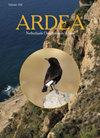大鸬鹚的gps追踪揭示了觅食行为的性别差异
IF 1.3
4区 生物学
Q3 ORNITHOLOGY
引用次数: 2
摘要
大蟾蜍Phalacrocorax carbo sinensis被认为是广泛的捕食者,在各种海洋和淡水栖息地以许多不同的猎物为食。然而,最近有越来越多的证据表明,即使是看似多面手的物种,也经常被视为一个多样化的个体专家群体,有时是由特定性别的觅食行为引起的。为了测试这是否也适用于大Cormorants,本研究通过在2012年繁殖季节对11只筑巢的雄性和雌性部署GPS记录仪,对大Cormorant的海上分布进行了表征,并检查了供应大Cormorat的时间预算。此外,根据这些标记鸟类的耳石和鱼骨记录,从其巢穴下方收集颗粒,进行详细的饮食分析。记录到了各种各样的觅食模式,从纯淡水觅食到近海觅食,记录到距离殖民地最远的距离为28公里。觅食行程中的时间预算显示,上岸休息时间相对较长(行程的55%±23%),其次是觅食(31±18%),飞行时间(15±11%)。比目鱼在这些大珊瑚虫的饮食中占主导地位,这表明在盐水中觅食时有底栖觅食策略(可以排除以抛弃物为食的可能性)。这项研究中的雄性避开了淡水觅食栖息地,更喜欢沙底的近海水域或岩石防波堤旁和港口内的近岸水域。雌性在所有栖息地觅食,但在内陆淡水水体中觅食的比例更高。雌性比雄性花更多的时间觅食,尤其是在海洋栖息地,而雄性休息得更多。有人提出,这些差异可能是由特定性别的觅食策略引起的,可能是由觅食地点的竞争引起的。本文章由计算机程序翻译,如有差异,请以英文原文为准。
GPS-Tracking of Great Cormorants Phalacrocorax carbo sinensis Reveals Sex-Specific Differences in Foraging Behaviour
Great Cormorants Phalacrocorax carbo sinensis are considered generalist predators feeding in a variety of marine and freshwater habitats on many different prey species. Recently however, there is increasing evidence that even seemingly generalist species can often be regarded as a diverse group of individual specialists sometimes induced by sex-specific foraging behaviour. To test whether this also holds true for Great Cormorants, the present study characterised the at-sea distribution and examined the time budgets of provisioning Great Cormorants by deploying GPS-loggers on 11 nesting males and females during the breeding season of 2012. Additionally, pellets were collected from underneath the nests of these tagged birds for detailed diet analysis, based on the otoliths and fish bones recorded within them. Diverse foraging patterns were recorded, ranging from exclusively freshwater feeding, to offshore foraging, with the furthest recorded distance from the colony being 28 km at sea. Time budgets during foraging trips revealed relatively long periods of resting ashore (55% of the trip ± 23%), followed by foraging (31 ± 18%), and time spent in flight (15 ± 11%). Flatfishes dominated in the diets of these Great Cormorants, indicating benthic-foraging strategies when foraging in saltwater (feeding on discards could be ruled out). The males in this study avoided freshwater foraging habitat and preferred offshore waters with a sandy bottom or nearshore waters alongside rocky breakwaters and within harbours. Females foraged in all habitat types, but proportionally more in inland freshwater bodies. Females spent more time on foraging than did males, particularly in marine habitats, whilst males rested more. It is proposed that these differences might have been caused by sex-specific foraging strategies, possibly resulting from competition at foraging sites.
求助全文
通过发布文献求助,成功后即可免费获取论文全文。
去求助
来源期刊

Ardea
生物-鸟类学
CiteScore
2.10
自引率
0.00%
发文量
49
审稿时长
>12 weeks
期刊介绍:
Ardea is the scientific journal of the Netherlands Ornithologists'' Union, and is published since 1912. The journal welcomes manuscripts reporting significant new findings in ornithology, in particular those covering the ecology, life history, and evolution of birds, and including sound descriptive work. Ardea publishes Original research papers, Short notes and Book reviews. In addition to the regular three issues per year, Ardea publishes specials that contain conference or workshop proceedings (produced on request).
 求助内容:
求助内容: 应助结果提醒方式:
应助结果提醒方式:


